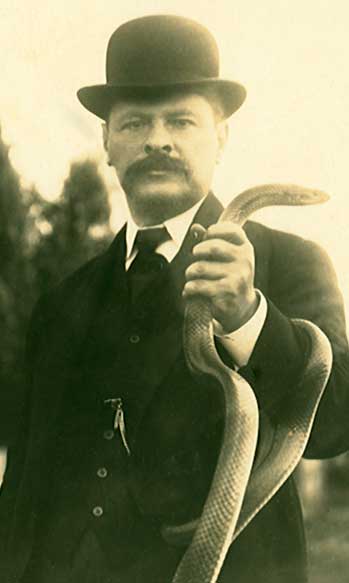
DISSEINATION: INSTITUTO BUTANTANVital Brazil in 1912DISSEINATION: INSTITUTO BUTANTAN
In 1911, the immunologist Maurice Arthus completed an experiment in France that confirmed the most important works of the physician Vital Brazil, who, ten years earlier, had shown that the action of anti-snake venom serum is specific, i.e., each serum immunizes only against the venom of one genus of snake. The serum against the venom of the cascavel rattlesnake (of the Crotalus genus), for example, is of no use to anyone bitten by a jararaca pit viper (of the Bothrops genus) and vice-versa. The French researcher’s investigation definitely settled all controversy around the discoveries made in Botucatu, inner-state São Paulo, and mainly at the Butantan Institute. These discoveries led to many lives being saved in the country. Also in February 1911, Vital Brazil published A defesa contra o ofidismo [Defense against ophidians), in which he compiled his great knowledge of Brazilian snakes and the prophylaxis against their venom. Arthus’ research served only to make official in Europe what had already been proven in Brazil in practice, when Butantan started to distribute anti snake venom serum to farmers.
Vital Brazil Mineiro de Campanha (1865-1950) came, as his name clarifies, from Campanha in Minas Gerais state. He graduated from the Rio de Janeiro Medical School in 1891 and moved to inner-state São Paulo to practice medicine, having been admitted into this state’s Public Health Service. Although he passed through other towns, his attention was particularly aroused in Botucatu, where there were a large number of farmhands attacked by poisonous snakes. This was where he began testing the efficacy of plant extracts against the venoms that sometimes killed in just a few hours. When in 1897 he went to work at what was then the Bacteriological Institute, with Adolpho Lutz, his experiments turned to using the very venom of the cascavel rattlesnake and the jararaca pit viper to immunize dogs and goats. His success in this endeavor led to the manufacturing of the earliest anti snake venom serums in 1901, the same year in which the Butantan Institute was officially established. “However, to get venom to make serum it was necessary to have snakes. Therefore, he set up an exchange system among farmers throughout the state: whoever sent snakes to Butantan got serum and syringes in exchange, to use as necessary,” says Nelson Ibañez, the director of the History of Science Laboratory at Butantan.
However, Vital Brazil did not start from scratch. He was aware of the work of two Frenchmen, Césaire Philalix and Gabriel Bertrand, conducted in 1894, which indicated it was possible to neutralize toxins by using anti-toxins extracted from the blood of animals immunized against the Vipera aspis venom, a snake from southwestern Europe. At the same time, Albert Calmette, who was also French, reached the same conclusion while working with Naja tripudians, a typically Asian snake. In 1896, Calmette produced a serum against this snake that he thought was effective against all serpent venoms. However, Vital Brazil showed right from the start of his own research, in 1897, that this did not hold true. Calmette’s serum, manufactured at the Pasteur Institute in Lille, France, had no effect on the venom of Brazilian snakes. Vital Brazil and the Frenchman initiated a scientific debate by mail that went on for years, until the thesis of the specificity of venom was internationally acknowledged. In 1914, A defesa contra o ofidismo was also published in France.
“Besides the social aspects, Vital Brazil’s studies had major implications for the development of immunology,” says Osvaldo Augusto Sant’Anna, from the Butantan Immunochemistry Laboratory, great-grandson of the scientist and coordinator of the National Institute of Toxin Science and Technology. “He showed how to use toxins in our favor. Today, there are drugs for hypertension and powerful analgesics that are derived from snake venom.”
Republish